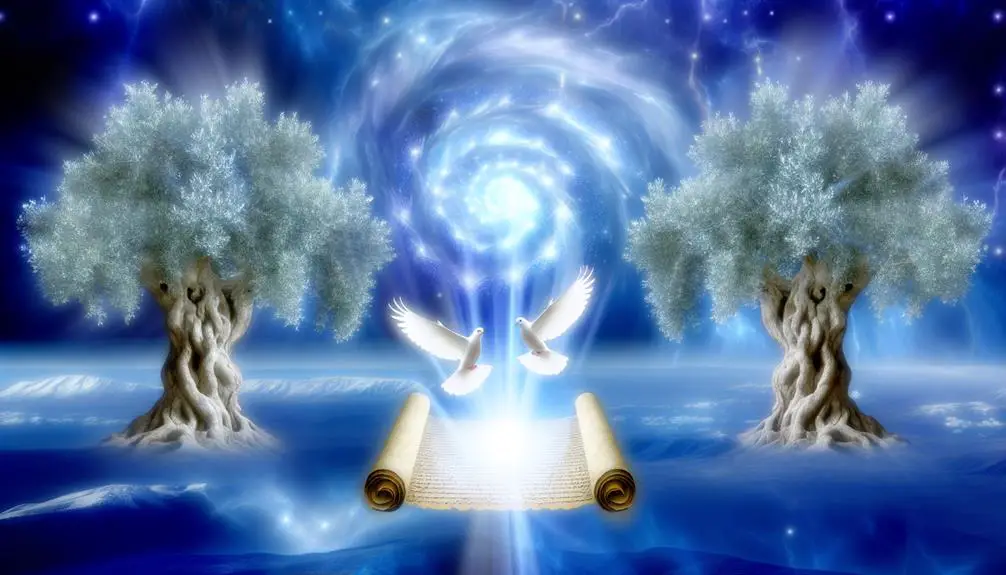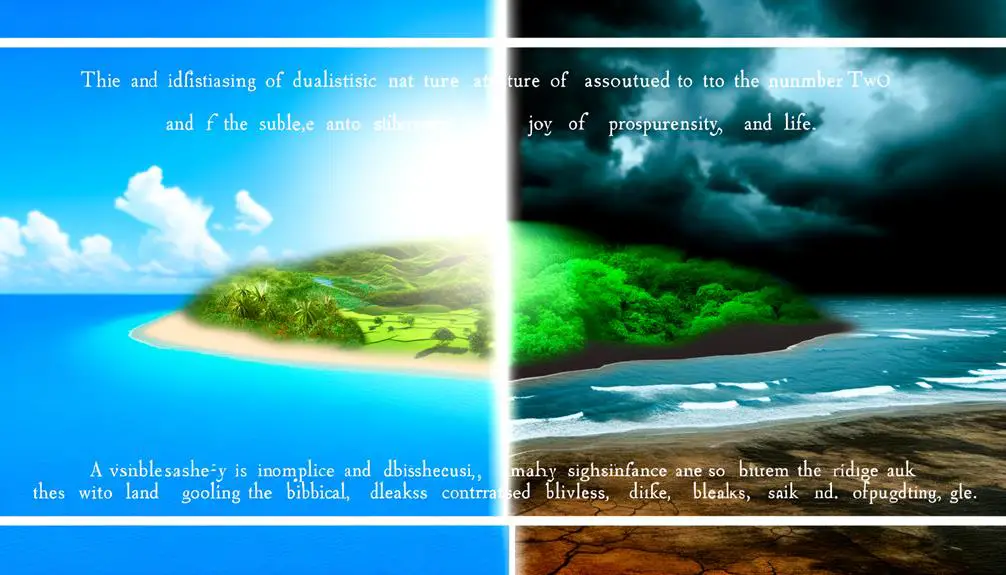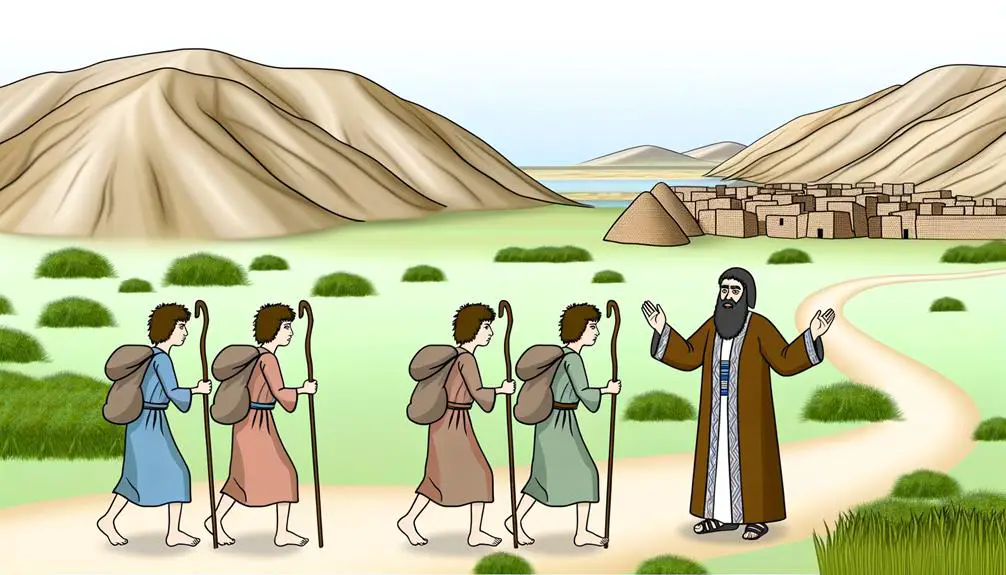Find out how the number two symbolizes union, testimony, and divine order in the Bible, revealing layers of meaning in its narrative.

What Does the Number Two Mean in the Bible
While you might initially think that a simple number like two doesn't carry much weight, in the Bible, it holds profound significance. You'll find it symbolizes union and partnership, especially in the contexts of marriage and the relationship between Christ and the church.
It's also pivotal in portraying witness and testimony, where two witnesses are required to establish truth. From the two great lights governing the day and night to Jesus sending disciples out in pairs, the number two weaves through scriptures, suggesting a deeper exploration.
This invites us to ponder how contrast, division, and ultimately, reconciliation are depicted, leaving a rich tapestry of meaning that's both intriguing and essential to understanding biblical narratives.
Key Takeaways
- The number two symbolizes union and partnership, highlighting the importance of unity in relationships and divine covenants.
- It also represents contrast and division, guiding moral and spiritual choices between righteousness and iniquity.
- In biblical narratives, sending disciples in pairs underscores the value of collaboration, support, and shared mission in spreading the faith.
- Number two holds significance in prophecies and revelations, indicating dual confirmations and the complex interplay between good and evil.
Symbol of Union and Partnership

In biblical context, the number two often symbolizes union and partnership, reflecting a foundational principle that two entities can achieve more together than apart. This concept isn't merely a fleeting theme but deeply ingrained in the scripture's narratives and laws, offering a profound insight into the spiritual significance of partnership.
At the heart of this symbolism lies marriage, arguably the most vivid portrayal of union in the Bible. You'll find that marriage isn't just a social contract; it's imbued with rich spiritual meaning, representing the covenant between God and His people. This covenant significance elevates the idea of marriage beyond mere human connection, portraying it as a divine bond and a mirror of God's promise to humanity.
As you delve deeper, you'll notice that the biblical narrative uses the concept of two to emphasize the strength and completeness found in unity. The notion that 'two are better than one' isn't just practical advice; it's a reflection of the belief that partnership, underpinned by commitment and mutual support, is central to fulfilling God's purpose for humanity.
Moreover, the symbolism of two as a covenant between individuals and God underscores the importance of relationships built on faithfulness and mutual respect. This covenantal aspect isn't limited to marriage but extends to all forms of partnership, highlighting the spiritual dimension of coming together in agreement and shared purpose.
In analyzing the biblical significance of the number two, it becomes clear that it's much more than a number. It's a symbol of the power of unity, the sanctity of marriage, and the depth of covenantal relationships, offering a timeless lesson on the value of partnership in achieving divine purposes.
Representation of Witness and Testimony

CURRENT SUBTOPIC: 'Representation of Witness and Testimony'
The number two's role extends beyond mere partnership, serving as a critical symbol for witness and testimony within the biblical narrative. This concept of dual confirmation is deeply embedded in the fabric of scriptural law and prophecy, underscoring the importance of corroborating evidence to establish truth. In Deuteronomy, the necessity of two or three witnesses to confirm a matter highlights the biblical principle that truth is more robustly verified through multiple testimonies.
Reference |
Context |
Significance |
|---|---|---|
Deuteronomy 19:15 |
Legal matters |
Emphasizes the need for multiple witnesses to confirm a case, illustrating the principle of dual confirmation. |
Matthew 18:16 |
Conflict resolution |
Echoes the Old Testament mandate, reinforcing the idea that matters of dispute require the testimony of two or three witnesses. |
Revelation 11:3-4 |
Prophetic witness |
Describes two witnesses as prophetic figures, embodying the theme of dual confirmation in eschatological prophecy. |
John 8:17-18 |
Jesus' testimony |
Jesus refers to the law of dual confirmation, asserting His testimony is validated by both Himself and His Father. |
This emphasis on dual confirmation extends to covenantal parallels. The two tablets of the Covenant, for example, signify a divine agreement witnessed by God and His people. The recurring theme of two witnesses throughout the Bible isn't merely a legal requirement but a profound demonstration of how truth and faithfulness are established and confirmed. It's a testament to the depth and complexity of biblical symbolism, where even a simple number can carry profound theological weight.
Contrast and Division

Beyond its role in establishing truth through witness and testimony, the number two also symbolizes contrast and division within the biblical context, offering a deeper layer of interpretation to its significance. This duality isn't merely about separating entities but about revealing the profound theological and moral divisions that guide human understanding and divine intention.
Consider the narrative of creation, where the concept of dividing waters illustrates a physical manifestation of division to bring about order and life. Here, the division isn't just a separation but a foundational act that delineates spaces, allowing for the flourishing of creation within the bounds set by divine command. This act of division underscores the theme of establishing harmony through separation, a principle that extends beyond the physical to the moral and spiritual realms.
Similarly, the depiction of contrasting kingdoms throughout biblical stories serves as a poignant reflection of this theme. These narratives often highlight the conflict between kingdoms of righteousness and those of iniquity, underscoring the moral divisions that the number two embodies. Such contrasts aren't merely historical or narrative devices; they're theological expositions that teach about the choices before humanity, between adherence to divine laws and the temptation of straying into moral decay.
Through these examples, you see that the number two, in its representation of contrast and division, isn't about division for its own sake. It's a vehicle for understanding the deeper moral and spiritual order that governs the world, highlighting the choices and consequences that define the human experience.
The Two Great Lights

The two great lights, created on the fourth day to govern the day and the night, serve as a profound demonstration of God's intention to instill order and mark time within the cosmos. These celestial bodies, the sun and the moon, aren't merely physical entities; they're imbued with rich creation symbolism, representing God's meticulous design and balance in nature. The sun dominates the day, a symbol of unwavering strength and light, whereas the moon governs the night, reflecting the sun's light and introducing the concept of lunar importance in marking time and seasons.
Delving deeper, you'll find that the dual nature of these lights mirrors the biblical theme of duality throughout the scripture. They epitomize the balance between light and darkness, day and night, providing a tangible representation of God's sovereignty over the universe. This duality isn't arbitrary; it's a cardinal aspect of the biblical narrative, illustrating how contrasting elements can coexist and fulfill divine purposes.
Moreover, the significance of the moon, often overshadowed by the sun's prominence, can't be understated. Its role in determining festivals and times highlights the lunar importance in the biblical context, showcasing a delicate balance between the solar and lunar cycles in harmonizing earthly life.
In essence, the creation of the two great lights is a testament to the complexity and beauty of God's design, a reminder of the order in the universe, and an illustration of the intricate interplay between different forces that govern existence. Through these celestial bodies, you're invited to ponder the deeper meanings embedded in the fabric of creation, revealing layers of symbolism and divine intention.
Jesus Sends Disciples in Pairs

Reflecting on the theme of duality within the biblical narrative, it's noteworthy that Jesus chose to send his disciples out in pairs, underscoring the importance of collaboration and support in fulfilling divine missions. This pairing strategy wasn't merely a logistical decision but a profound illustration of disciple dynamics and the inherent value in mutual aid and partnership in the Christian journey.
This approach by Jesus wasn't arbitrary. By sending them in pairs, He not only ensured their safety and support in practical terms but also imparted a deeper spiritual lesson. The act can be seen as a living parable, where the disciples' cooperation and mutual support symbolized the broader Christian principle of community and interdependence. It's a powerful testimony to the belief that one's faith is strengthened and one's mission is more effectively carried out in the company of another.
Moreover, the pairing strategy highlights the significance of witness. In a judicial sense in ancient times, the testimony of two witnesses was required to establish the truth of a matter. Similarly, by sending his disciples in pairs, Jesus ensured that their message would be validated through their collective witness. This not only lent credibility to their preaching but also modeled a form of evangelism rooted in shared testimony and collective faith expression.
Analyzing this element of disciple dynamics offers profound insights into the biblical understanding of partnership. It underscores the notion that in the mission of spreading the Gospel, collaboration isn't just beneficial; it's essential. The pairing of the disciples serves as a timeless reminder of the power and necessity of unity and mutual support in fulfilling one's divine calling.
Echoes in Revelations and Prophecies

You'll find the number two's significance deeply woven into the fabric of Revelations and biblical prophecies, revealing layers of meaning that demand careful interpretation.
The concept of dual prophecies interpretation underscores the complexity and depth of these scriptural passages, offering a lens through which to view unfolding events in both historical and spiritual dimensions.
Revelation's symbolic pairings further enrich this tapestry, inviting you to explore the profound interplay between the tangible and transcendent.
Dual Prophecies Interpretation
Throughout biblical scripture, dual prophecies often serve as a bridge, connecting the ancient wisdom of the Old Testament with the revelations found in the New Testament. These prophecies, rich with parallel narratives and ambiguous meanings, invite you to delve deeper into their interconnectedness. They're not just stories or predictions; they're a sophisticated blend of messages intended for multiple fulfillments across time.
Aspect |
Old Testament |
New Testament |
|---|---|---|
Nature of Prophecy |
Immediate Context |
Eschatological Fulfillment |
Key Figures |
Prophets |
Jesus |
Symbolism |
Temple, Jerusalem |
New Heaven, New Earth |
Audience Expectation |
Liberation |
Ultimate Salvation |
Interpretation |
Historical |
Theological |
This intricate weaving of themes showcases the Bible's depth, urging you to look beyond the surface and appreciate the dual layers of prophecy.
Revelation's Symbolic Pairings
Building on the foundation of dual prophecies, the Book of Revelation introduces symbolic pairings that further illuminate the Bible's complex tapestry of messages and meanings. As you delve deeper, you'll discover the intricate balance between darkness and light, epitomized by the beastly duo and their heavenly counterparts. These connections aren't merely coincidental; they're meticulously crafted to offer insights into the cosmic struggle between good and evil.
- The beastly duo symbolizes the pinnacle of earthly corruption and defiance against divine order.
- Their heavenly counterparts represent purity, justice, and the ultimate victory of good over evil.
- This duality emphasizes the ongoing spiritual battle and the importance of choosing sides.
- It serves as a reminder of the binary nature of existence, urging believers to align with the forces of light.
Frequently Asked Questions
How Does the Number Two Relate to the Concept of Balance and Duality in Other Spiritual Traditions Outside of Christianity?
In various spiritual traditions outside of Christianity, the number two often symbolizes balance and duality, much like the Yin Yang concept in Taoism. This principle highlights the interconnectedness and interdependence of opposite forces, illustrating how they can coexist harmoniously.
Similarly, the idea of Dual Spirits in some beliefs reflects the two-sided nature of existence, emphasizing that life's complexities are best understood through the lens of balance and duality.
Are There Any Instances Where the Number Two Is Associated With Negative or Cautionary Themes in the Bible?
In your exploration, you'll find the Bible associates the number two with both unity and division, leading to a pairing paradox. Notably, it sometimes signals double trouble, hinting at cautionary tales.
For instance, the two witnesses in Revelation bring a message that's both salvific and judgmental. This duality underscores a complex narrative where two can symbolize opposition, challenge, and the necessity for discernment, embodying a profound, multifaceted spiritual truth.
How Has the Symbolism of the Number Two Impacted Christian Art and Architecture Throughout History?
You might think the symbolism of two doesn't significantly impact Christian art and architecture, but it profoundly does. Dualistic motifs, reflecting themes like the duality of nature and divine, permeate these fields.
This artistic representation isn't just decorative; it's deeply insightful, offering a glimpse into the theological underpinnings of Christianity. Through sculptures, paintings, and architectural designs, the number two informs and enriches the spiritual and aesthetic landscape of Christian history.
Can the Significance of the Number Two Be Linked to Any Specific Biblical Figures or Stories Not Directly Mentioned in Common Interpretations?
Absolutely, the significance of the number two extends to specific biblical narratives, notably through Dual Prophets and Covenant Pairs. Consider Moses and Aaron as a pair leading Israel, symbolizing leadership and priesthood.
Additionally, Elijah and Elisha's prophetic succession illustrates the transfer of divine power. These pairs embody the concept of partnership in fulfilling God's will, offering a deeper, more nuanced understanding of their roles within the biblical context.
How Do Modern Theologians Interpret the Role of the Number Two in Contemporary Christian Practice and Belief Systems?
You're diving into how theologians see the number two shaping Christian practices today.
They often link it to 'two witnesses' and 'divine partnerships,' symbolizing confirmation and unity within the faith.
This interpretation isn't just about counting; it's deeply analytical, suggesting that two represents balance, collaboration, and the strength found in partnerships.
It's a scholarly perspective that enriches understanding, showing how ancient symbols influence contemporary belief systems in insightful and meaningful ways.
Conclusion
In the rich tapestry of biblical symbolism, the number two weaves a dual thread of unity and division, reflecting life's inherent contrasts. It embodies partnership, as seen in the creation of two great lights and Jesus' strategic sending of disciples in pairs, yet it also signifies division, echoing through the stark narratives of Revelation.
This duality offers a profound commentary on the human condition, encapsulating the essence of testimony and challenge, and illuminating the path from discord to harmony.



Sign up